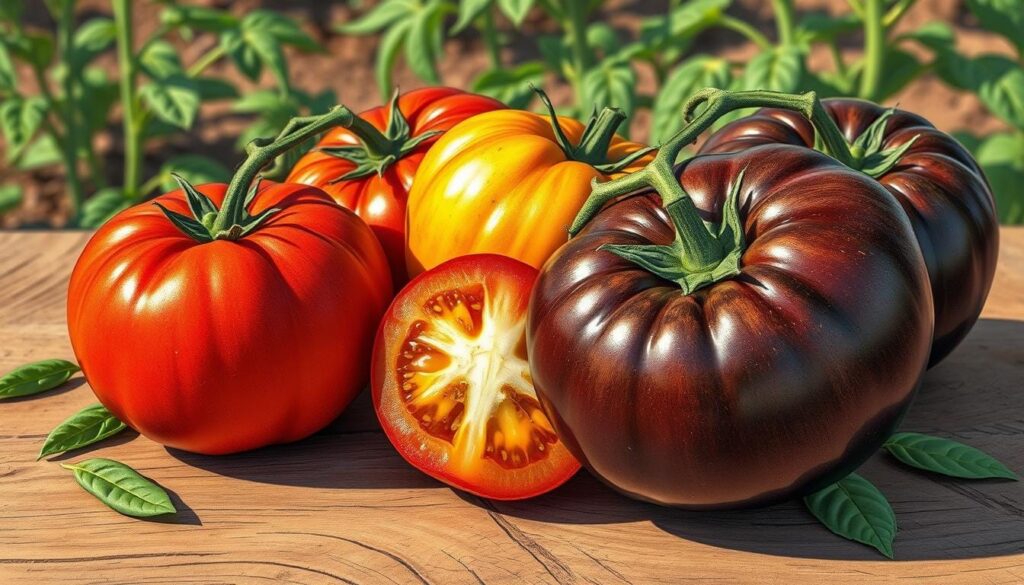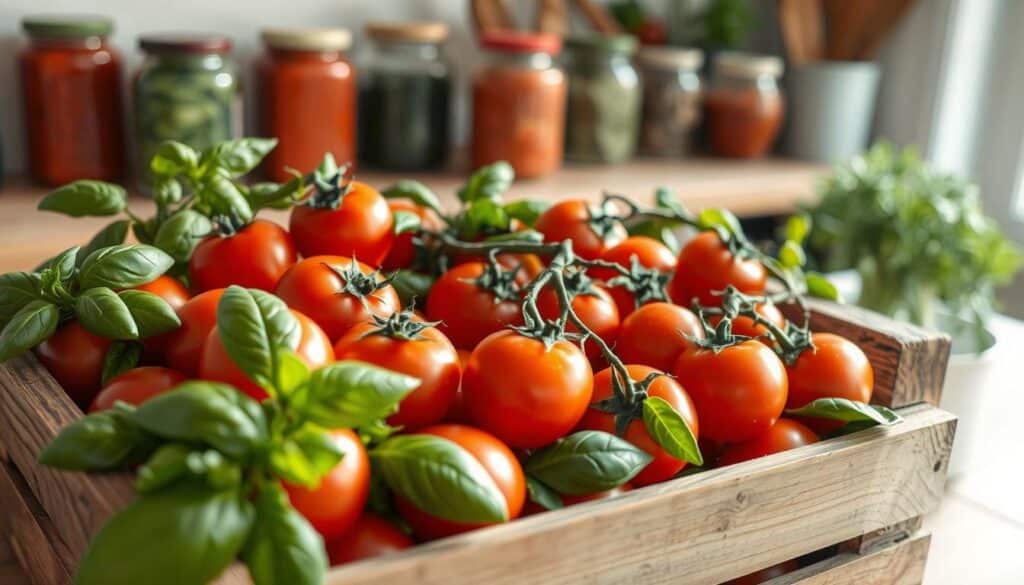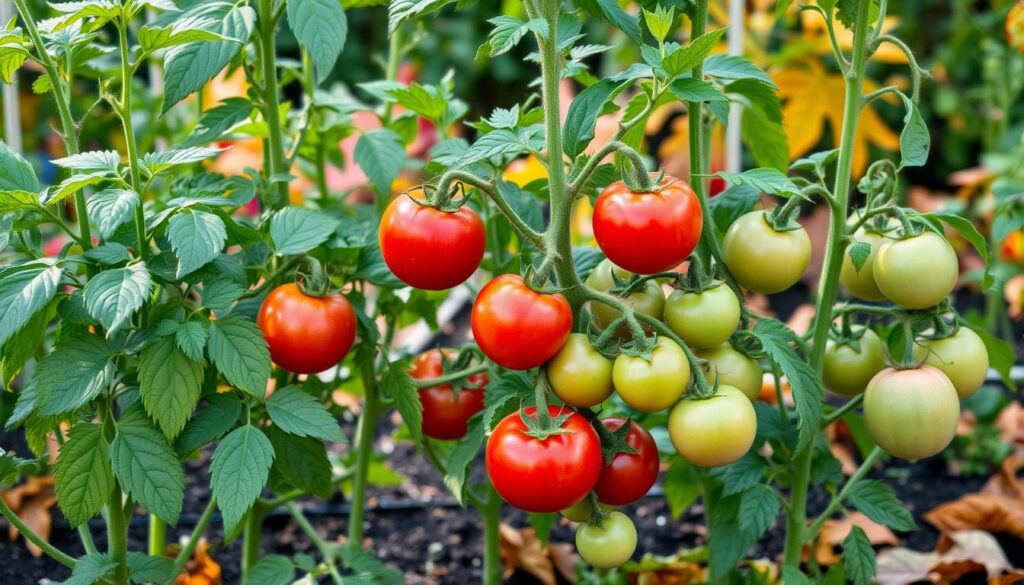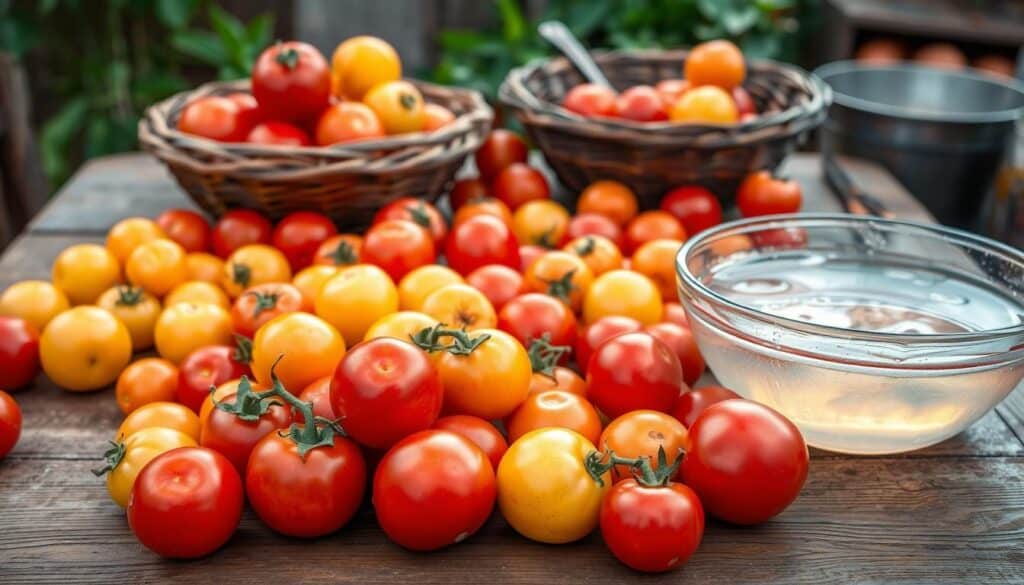The sun-drenched garden whispers promises of crimson treasures. Growing tomatoes isn’t just a hobby—it’s a journey of patience, care, and anticipation. Every gardener knows the excitement of watching green fruits transform into vibrant, ripe tomatoes ready for harvest.
Understanding when to harvest tomatoes can make a big difference. It can turn bland, mealy fruit into garden-fresh delights. We’ve learned that timing is everything in the tomato harvesting season. Selecting disease-resistant varieties and mastering the art of harvesting can elevate your gardening experience from ordinary to extraordinary.
Our guide will walk you through the process of knowing exactly when tomatoes are harvested. This ensures you capture peak flavor and nutrition from every precious fruit.
Key Takeaways
- Tomato harvesting requires careful observation of fruit color and ripeness
- Different tomato varieties have unique maturation timelines
- Temperature plays a critical role in tomato ripening
- Morning harvests help preserve fruit quality
- Proper storage can extend tomato freshness
Understanding the Tomato Growth Cycle
Tomato plants start as tiny seeds and grow into fruitful plants. We explore their growth cycle to find the best time to harvest tomatoes. This helps us understand when to pick our tomato crops.
The tomato growth cycle has several key stages. These stages are important for planning when to harvest our tomatoes:
- Germination (5-10 days)
- Early Growth Stage
- Vegetative Growth
- Flowering
- Pollination
- Fruit Formation
- Ripening
The Different Stages of Growth
Knowing each growth stage helps gardeners plan their harvest. Seeds germinate when the soil is between 68°F to 78°F. This starts the plant’s growth.
| Growth Stage | Duration | Key Characteristics |
|---|---|---|
| Germination | 5-10 days | Soil temperature 55-70°F |
| Vegetative Growth | 20-25 days | Side shoot formation |
| Fruit Development | 40-60 days | Fruit sizing and color development |
How Weather Influences Growth
Weather is key for the best tomato harvest. The ideal conditions are:
- 8-10 hours of direct sunlight daily
- Consistent soil moisture (1-2 inches per week)
- Temperature range between 55°F and 85°F
“Tomatoes are living thermometers of your garden, responding dramatically to environmental conditions.” – Garden Wisdom
Our tomato plants need careful watching at each stage. Indeterminate varieties keep producing fruits all season. Determinate types ripen at once, requiring different harvest plans.
Ideal Conditions for Tomato Harvesting
To grow perfect tomatoes, you need to know about the right environmental conditions. Our guide will show you how to pick tomatoes at the best time. It will also help you create the perfect place for growing tomatoes.
For tomatoes to grow well, several important factors are needed. These factors affect the health of the plants and how many tomatoes they produce. Let’s look at what makes a tomato garden thrive.
Temperature Requirements for Optimal Growth
Tomatoes are very sensitive to temperature changes. They grow best in certain conditions:
- Daytime soil temperatures must exceed 60°F
- Nighttime temperatures should remain above 50°F
- Ideal growing temperatures range between 65°F and 85°F
Soil Moisture and Quality Considerations
The right soil is key for a great tomato harvest. Here are some tips for managing your soil:
| Soil Characteristic | Recommended Specification |
|---|---|
| pH Level | 6.5 to 7.0 |
| Organic Matter | 2-3 inch compost layer |
| Mulch Depth | 2-3 inches of shredded bark |
| Plant Spacing | 24-30 inches apart |
Keeping the soil moist is important for a good tomato harvest. Don’t overwater or underwater. A good rain after a dry spell can make tomatoes crack, so watch your plants closely.
“The secret to great tomatoes lies in understanding their environmental needs and providing consistent care.” – Experienced Gardener
By focusing on temperature and soil, we can make the best conditions for tomatoes. This will help them grow strong and give us a big harvest.
Factors Affecting Harvest Timing
Tomato harvesting is complex, with many factors affecting fruit development and maturity. We aim to guide gardeners through the process of finding the best time to harvest their tomatoes.
Each tomato variety has its own challenges in identifying when they are ripe. The time it takes for tomatoes to mature varies, usually between 60 to 100 days after they are planted.
Tomato Variety Considerations
Choosing the right tomato variety is key to a successful harvest. Here are important factors to consider:
- Genetic growth characteristics
- Expected maturation period
- Regional climate adaptability
- Disease resistance
Pest and Disease Management
Pests and diseases can harm tomato plants and affect when they are ready to harvest. Common issues include:
- Tomato hornworms
- Early blight
- Bacterial spot
- Fusarium wilt
“Vigilant monitoring is the gardener’s best defense against crop destruction.”
Our studies show that managing pests and diseases is vital for tomato growth. Using integrated pest management can help protect your tomatoes and ensure they are of the best quality.
To track when tomatoes are ripe, watch for color changes, texture, and plant health. By understanding these factors, gardeners can improve their tomato crop’s quality and enjoy a full harvest.
Signs of Ripe Tomatoes
Knowing when to pick tomatoes can greatly improve their taste and quality. Our guide will teach you how to spot ripe tomatoes and understand when they’re ready.

Checking for ripe tomatoes involves looking at several important signs. These include color changes, texture shifts, and specific visual signs.
Color Transformation Process
Color is the main way to tell if tomatoes are ripe. Each type of tomato ripens differently:
- Red varieties change from green to deep red
- Pink tomatoes transition to soft pink hues
- Yellow types develop vibrant golden colors
- Burgundy-black varieties show rich, deep tones
Texture and Firmness Analysis
Texture also tells you a lot about tomato ripeness. Ripe tomatoes have certain qualities:
| Ripeness Indicator | Description |
|---|---|
| Softness | Slightly soft, similar to a ripe peach |
| Vine Attachment | Easily separates with gentle twist |
| Surface Appearance | Shiny and glossy |
“The art of tomato harvesting lies in understanding subtle maturity signals.”
Pro tip: August is the best time to pick tomatoes in most U.S. areas. Look for tomatoes that are a bit soft but not too mushy. They should have a deep, even color and no green spots.
Learning these signs will help you pick tomatoes at their best flavor. This will make your gardening more enjoyable and rewarding.
Best Practices for Harvesting
Tomato growing is a favorite hobby for 95% of American gardeners. It’s important to know the best ways to pick tomatoes. Our guide will teach you how to pick tomatoes with care and precision.
Harvesting tomatoes well needs preparation and the right tools. We’ll look at the key tools and methods for a healthy and full crop.
Essential Tools for Harvesting
- Sharp garden pruners
- Clean, sharp knife
- Harvesting basket or container
- Gardening gloves
Proper Harvesting Techniques
When picking tomatoes, it’s important to handle them gently. This helps keep the fruit quality high. Here are our top tomato harvesting tips:
- Grasp the tomato firmly but gently
- Twist the fruit slightly to remove from the vine
- Use pruners for stubborn stems to prevent plant damage
- Cut the stem close to the fruit if needed
| Tomato Type | Harvesting Recommendation | Optimal Picking Time |
|---|---|---|
| Cherry Tomatoes | Pick at early color stages | When slightly soft to touch |
| Beefsteak Tomatoes | Full color development | When deeply colored and slightly soft |
| Heirloom Varieties | Handle with extra care | When fully ripe and deep in color |
Pro tip: For ripening tomatoes indoors, keep the temperature between 70-75°F. Pick tomatoes in the cooler parts of the day to keep them fresh.
Remember, the key to successful tomato harvesting is patience and gentle handling.
By using these techniques, you’ll get the most from your harvest. Enjoy the freshest, tastiest tomatoes right from your garden.
Harvest Timing Based on Geography
The tomato harvesting season changes a lot across the United States. This is because of different climates and geography. Knowing these differences helps gardeners grow tomatoes better.
Every region has its own tomato harvest time. This is because of their unique climates. Let’s look at how geography affects tomato harvest times across the country.
Regional Harvest Variations
Several factors affect when tomatoes are ready to harvest:
- Geographical location
- Local temperature ranges
- Length of growing season
- Specific climate zone characteristics
Climate Considerations Across U.S. Zones
Our study shows big differences in tomato harvest times:
| Climate Zone | Peak Harvest Period | Growing Season Length |
|---|---|---|
| Southern Zones (8-10) | April – November | Extended |
| Midwestern Zones (4-7) | June – September | Moderate |
| Northern Zones (1-3) | July – August | Short |
In the North and Midwest, where growing seasons are short, plant tomatoes by the third week in June. In the South, where seasons are longer, you can plant until the second week in July.
“Know your zone, plan your tomato harvest!” – Garden Wisdom
Knowing your region’s tomato harvest time is key to a good crop. Timing is everything for growing tomatoes well.
Harvesting Heirloom vs. Hybrid Varieties
Choosing between heirloom and hybrid tomatoes can be tough for gardeners. Knowing the differences helps us pick the right tomatoes for our gardens. This way, we can harvest them at the perfect time.
Heirloom tomatoes come from a long history of farming. They have unique tastes and looks that set them apart. These tomatoes are a treasure from the past.
Unique Characteristics of Tomato Varieties
- Heirloom Tomatoes:
- Passed down through generations
- Diverse in size and shape
- Often more flavorful
- Genetically diverse
- Hybrid Tomatoes:
- Intentionally cross-pollinated
- Disease-resistant
- Uniform in size and appearance
- Consistent fruit production
Flavor Profiles and Harvesting Considerations
Choosing the right time to pick tomatoes depends on their type. Heirloom tomatoes need more attention because they ripen differently.
“The beauty of heirloom tomatoes lies in their unpredictability and rich flavor complexity.” – Garden Enthuasiast Magazine
| Variety Type | Flavor Intensity | Disease Resistance | Harvest Complexity |
|---|---|---|---|
| Heirloom | High | Low | Moderate |
| Hybrid | Moderate | High | Low |
We suggest trying both heirloom and hybrid tomatoes. Hybrid tomatoes are reliable, while heirloom tomatoes offer a special taste. By knowing their differences, we can harvest our tomatoes better and enjoy a delicious crop.
Storage and Handling After Harvest
Keeping tomatoes fresh is key. Knowing how to harvest them right can help a lot. This way, we keep their taste and nutrients.

Temperature is very important for storing tomatoes. We’ve found some great tips to keep them tasty and fresh.
Ideal Storage Conditions
Knowing the right conditions is essential for storing tomatoes. Handling them carefully after picking is also important.
- Store tomatoes at room temperature (around 68°F)
- Keep away from direct sunlight
- Avoid refrigeration, which can compromise flavor
Extending Shelf Life
When we pick tomatoes at the right time, they last longer. Here are some tips to keep them fresh:
| Storage Method | Expected Shelf Life | Key Considerations |
|---|---|---|
| Room Temperature | 5-7 days | Maintain 50-60°F with 60% humidity |
| Cool, Dark Location | Up to 2 weeks | Use perforated containers |
| Stem-Side Down Storage | Extended freshness | Prevents moisture loss |
“The art of tomato storage is as important as the harvest itself.”
Improper storage can lead to a lot of waste. By using these tips, we can cut down on waste. And enjoy our tomatoes for longer.
Common Mistakes in Harvesting Tomatoes
Harvesting tomatoes might seem easy, but many gardeners make common mistakes. These mistakes can hurt the quality of their tomatoes. Knowing when to harvest tomatoes is key, and it depends on several factors.
Recognizing Tomato Maturity Indicators
It’s important to know when to pick tomatoes. Our tips help avoid two big mistakes:
- Overripe tomatoes: These are soft, mushy, and spoil quickly
- Underripe tomatoes: They taste bad and aren’t as nutritious
Soil and Weather Complications
Weather affects tomato harvesting a lot. Gardeners often miss important signs from the environment. Too much water can cause root rot, while too little can make fruits crack and develop blossom end rot.
“Timing is everything in tomato harvesting—too early or too late can mean the difference between a bountiful, flavorful crop and a disappointing harvest.”
Key Harvesting Considerations
- Watch the daily temperature changes
- Check the soil moisture often
- Look at the fruit’s color and firmness
- Know what your tomato variety needs
By focusing on these points, we can avoid mistakes and get a great tomato harvest. This way, our tomatoes will taste better and be more nutritious.
How to Extend the Harvest Season
Gardeners can make the most of their tomato harvest by planning smart and using new growing methods. We aim to help you enjoy fresh tomatoes longer than usual.

To extend the tomato harvest, you need to think about a few key strategies. Successful gardeners know that timing and technique are key to growing tomatoes longer.
Techniques for Late Crops
Here are some effective ways to extend your tomato harvest:
- Plant multiple successions 3-4 weeks apart
- Reduce supplemental watering in late summer
- Sever roots on three sides to trigger fruit production
- Pull tomatoes with 50% redness before temperature drops
Indoor Growing Options
Indoor growing opens up new chances for growing tomatoes all year. Indeterminate varieties are great for year-round growing.
| Growing Strategy | Potential Harvest Extension |
|---|---|
| Greenhouse Cultivation | Year-round production |
| Indoor Container Gardening | 3-4 additional months |
| Grow Lights and Controlled Environment | Continuous harvesting |
“With the right techniques, your tomato garden can be a source of fresh produce far beyond the traditional growing season.” – Gardening Expert
Keeping temperatures between 60°F and 95°F is key for growing tomatoes all year. Places with warm climates can grow tomatoes longer. But, in cooler areas, you need to plan more carefully.
By using these methods, we can make our tomato harvest last longer. And we can enjoy fresh, homegrown tomatoes for more months.
The Importance of Regular Harvesting
It’s key to pick tomatoes regularly to get the most from your plants. Our ways of picking tomatoes help keep the plants healthy and productive.
- Stimulates continued fruit production
- Prevents overripe tomatoes from damaging the plant
- Reduces pest and disease risks
- Encourages the plant to continue flowering and producing new fruits
Impact on Plant Productivity
By picking ripe tomatoes often, we make room for new ones to grow. Removing mature tomatoes tells the plant to make more blossoms. This keeps the plant busy making more fruit.
“The key to a successful tomato harvest is understanding the plant’s response to regular picking.” – Gardening Expert
Encouraging Continued Fruit Production
How we pick tomatoes affects how much they grow. Picking them when they’re just ripe – usually 2-3 days after they turn bright – helps a lot:
- Prevents fruit from becoming overripe
- Reduces stress on the plant
- Maintains a steady supply of fresh tomatoes
- Protect against pest infestations
When we harvest, we should cut the fruit with a bit of stem left. Use clean pruners and don’t pull on the fruit to avoid harming the branch.
Post-Harvest Care
After we harvest our tomatoes, we need to take care of them. This helps keep their quality high and gets us ready for next year’s crop.

Cleaning and Sorting Tomatoes
Cleaning is key in our tomato harvesting plan. We check each tomato closely. We remove any that are damaged or sick to stop pests.
- Separate damaged tomatoes from healthy ones
- Use soft brushes or cloths for gentle cleaning
- Avoid washing tomatoes until immediate use
- Inspect for bruises, cuts, or soft spots
“Quality preservation starts with meticulous post-harvest care” – Agricultural Experts
Preparing Garden for Next Season
Our tomato harvesting doesn’t stop with the current crop. We also prepare the garden for the future. This includes managing the soil and rotating crops.
- Remove old tomato plants completely
- Test soil pH and nutrient levels
- Add organic compost to replenish nutrients
- Consider crop rotation to prevent soil depletion
Pro tip: Clean garden tools with alcohol to prevent disease transmission between seasons.
By following these steps, we ensure our tomatoes are always of the best quality. This way, we can keep growing great tomatoes at home.
Frequently Asked Questions About Harvesting
Tomato harvesting can be tricky, leaving many gardeners with questions. We’ll look into common questions about when to harvest tomatoes. We’ll also explore the best time to pick them to help you garden with confidence.
The Best Time of Day to Harvest
When to pick tomatoes is key. Our gardening experts say to harvest in the early morning or late afternoon. These times are cooler, making tomatoes juicier and tastier.
- Early morning harvest preserves maximum fruit moisture
- Avoid midday heat which can cause stress to the plants
- Pick when fruits are dry to prevent fungal issues
Can Tomatoes Ripen Off the Vine?
Yes, tomatoes can ripen after being picked. Mature green tomatoes with a hint of color can ripen well off the vine.
“Nature provides tomatoes with an incredible ability to mature even after separation from the plant.” – Gardening Experts
Here are some tips for ripening tomatoes:
- Store at room temperature (around 70°F)
- Place near other ripening fruits like bananas
- Check daily for optimal ripeness
Knowing these tips can help you get the most from your tomato crop. Enjoy delicious, perfectly ripe tomatoes all season long.
Environmental Impact of Tomato Harvesting
Tomato farming is a big part of our food system. Knowing how our tomato harvesting affects the environment helps us choose better ways to grow food.
Our choices in harvesting tomatoes have a big impact on the planet. New studies show us how to farm in ways that are kinder to the earth.
Sustainable Farming Practices
We can lessen our harm to the environment by using smart tomato harvesting methods:
- Use drip irrigation to save water
- Choose organic fertilizers over chemicals
- Rotate crops to keep soil healthy
- Use natural ways to fight pests instead of chemicals
Reducing Garden Waste
Our tomato harvesting can also cut down on waste and harm to the environment:
| Practice | Environmental Benefit | Impact Reduction |
|---|---|---|
| Efficient Irrigation | Water Conservation | 25% per acre reduction |
| Precision Harvesting | Food Waste Minimization | 31% reduction in waste |
| Sustainable Processing | Carbon Footprint Reduction | 5-43% improvement |
*”Every tomato we grow and harvest sustainably is a step towards protecting our planet.”*
By choosing eco-friendly tomato harvesting, we help make farming better for the future. What we do in our gardens can really make a difference.
Remember, growing tomatoes sustainably is more than just growing food. It’s about taking care of our planet’s resources.
The Role of Tomatoes in Our Diet
Tomatoes are packed with nutrients and offer many health benefits. When tomatoes are ripe, they taste the best and are most nutritious. This is the perfect time to enjoy them.
- Contains essential vitamins like vitamin C and K
- Rich in potassium and powerful antioxidants
- Low in calories (approximately 18 calories per 100 grams)
- High water content (around 95%)
Nutritional Powerhouse
Tomatoes are full of good stuff. Lycopene, a key antioxidant, is a big health booster. Studies show it can lower bad cholesterol and might help prevent some cancers.
“Tomatoes are not just a food, they’re a natural medicine cabinet.” – Nutritional Expert
Culinary Versatility
Tomatoes are great in many dishes. They’re perfect for salads, sauces, and more. Knowing when tomatoes are ripe helps us use them in the best way.
Here are some tasty ideas:
- Fresh salsa
- Homemade pasta sauces
- Grilled vegetable medleys
- Smoothies and juices
By learning about tomatoes’ health and cooking uses, we can make our diet better. This leads to a healthier life.
Conclusion: Timing is Key for a Successful Tomato Harvest
Learning when to harvest tomatoes is more than just picking red fruits. With so many varieties like Beefsteak, Cherry, Heirloom, and Roma, each garden is different. We must pay close attention to how they ripen and the weather.
The right time to pick tomatoes depends on many things. This includes the type of tomato, the weather, and how each plant grows. Picking tomatoes in the morning can make them taste better. Some tomatoes keep producing until it gets cold, while others all ripen at once.
Summary of Key Points
We’ve learned a lot about when to pick tomatoes. Knowing the five stages of ripening and the best temperatures is key. Regular picking keeps tomatoes fresh and flavorful for our cooking.
Encouragement to Start Our Tomato Adventure
Now we’re ready to make our gardens full of tomatoes. Whether you’re growing early, mid-season, or late-season tomatoes, each plant has its own story. Let’s enjoy the journey, learn from each harvest, and celebrate the variety of these amazing fruits.

